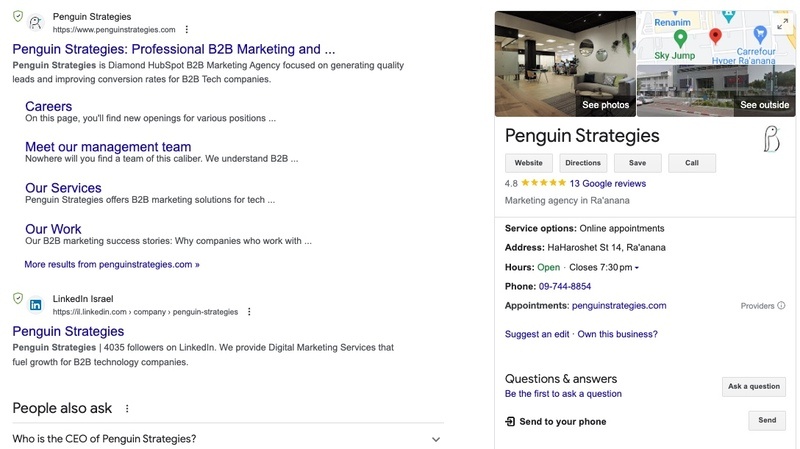
We’ve all heard over and over the most important things you need for your B2B company to succeed at its SEO strategy: Keyword optimization, page speed, backlinks, domain authority…B2B SEO…yada yada yada.
So we’re not here to lather, rinse, repeat what you know. We’re not going to tell you “all you need to do is “X” but in reality, “X” takes tens of hours to learn, dozens of hours to implement, and requires continuous upkeep to keep it running. By no means are we saying to ignore those big-ticket items. They play a huge role in your overall SEO needs, and if you leave them high and dry, your SEO strategy won’t go far.
This list is here to give you “relatively” simple techniques and practices that typically fly under the radar but can help your website climb higher and higher in those SERPs.
So, what are these overlooked SEO hacks?
- Schema markup
- FAQs
- Adding a transcript to your video pages
- Google my business profile Internal Links
- PR Grabs and Media Coverage
- Quora
- Bonus - Wikipedia
Schema Markup
Schema markup was established to create a common language for mutual understanding between a webpage and search engines. While that sounds like a whole bunch of jargon, Schema allows search engines to understand your content better quickly, helping Google and the like place your content high in the search results (assuming your content is relevant and good).
Adding Schema into the code of your page (don’t worry, it’s not difficult), offers numerous B2B SEO benefits including:
- Ranking factor
- Authority
- Rich snippets
Schema markup is relatively easy to implement with plug-ins and schema generators and can have many benefits.
You can check out our previous blogs on the why and the how of Schema markup to learn more.
Level Up Your FAQ
Adding a FAQ (frequently asked questions) section to your page makes it easier to read (for both humans and robots) and provides a way for readers to get answers to their burning questions quickly. Besides for the boost to the readers, FAQ sections can greatly enhance your B2B’s SEO results.
By writing in question-and-answer format, you give yourself a better chance for a page to be displayed in the “People also ask” section of search engine results as well as better overall placement in the SERPs. These placements can significantly improve your CTR.
Let’s talk about a few implementation methods.
1. Dedicated section - Add a dedicated FAQ section to the bottom of a page in a question/answer format. You can see an example at the bottom of this page. You can add questions with short answers pertaining to the topic of the page.
2. Dedicated page - Here, you can create pages dedicated to FAQs without other content on the page. This can be for all questions related to any page on your site, or you can create them by topic. This may allow for a nicer format as you are not restricted by an existing page’s format, and you can answer questions on a variety of topics in one place.
The cons to this style: 1) You need to create a new page as well as page style. 2) You might not want to keep adding pages to your site. 3) If people land on this page, it may be harder to navigate around the site compared to having them land on a page optimized for a user’s flow.
3. Built into the content - You can also scrap the whole idea of building dedicated spaces for your questions and answers and put your FAQs straight into the content. We highly recommend you make your H2s into questions (when possible, no need to overdo it) and just have the following paragraph act as an answer. This won’t take much additional effort to implement and will seem more natural to readers.
The con with this method is that since the questions and answers are directly in the content, you likely won’t be able to “manipulate” the text as much to suit your SEO needs.
Video/Podcast Transcripts
Often (well, at least we hope), your company will have videos they can share on your site or your social media pages. Whether it’s a webinar, a product demo, a new podcast you’re trying out, or something else. Video, and now podcasts, have become “power” assets. But with this power comes great responsibility.
Since videos are not text-based, there is not much that search engines can scan when viewing a page with only a video. Usually, the only readable files that are on a page with a video (especially a page that hosts only a video) are the title and maybe a short description…as well as the alt text. This makes your entire video a worthless asset for SEO purposes. (Do you know how to fix this?)
It’s widely suggested that you have subtitles on all your videos so that people are able to view them without sound. If you already have subtitles, it means you already have a transcript. And if you already have a transcript, then you're 90% there.
While you may not already have subtitles for your podcast, you may have a script (also true of video). And if not, for both video and podcast, there are plenty of tools that can quickly generate a transcript from your video or audio file automatically. If you do this, you MUST review the generated transcript, as they are often far from perfect.
All that remains now is to add the transcript to your website in a way that search engines can read the text. This is what gives your video an SEO boost.
This can be done in multiple ways:
1. Adding the transcript straight to the page. This allows both the users and search engines to read the transcript. You can just place the text straight onto the page as you have it from the transcript, but we would suggest that you reformat it so that it is easier for readers to scan.
You can also add the text with time stamps, but again, make sure the readers can read it and it doesn’t look too crowded on the page. Some examples of companies who do a good job with this are B2Linked, SMA Marketing, and the podcast This American Life.
2. Another way to get the benefit of SEO from your video is to simply add the transcript to the HTML of your page. This would allow the search engines to understand what your video is about without filling up your landing page with a huge amount of text.
A different option is to upload a plain-text file (such as SRT or VTT) ALONGSIDE your video file. Here, too, your B2B will get the SEO benefit without adding the transcript to your page. It is important to note that simply adding an mp4 or any video file with subtitles inside it WILL NOT affect SEO. Search engines can only read the subtitles if they are coming from a separate text-based file.
Google My Business Profile

This one is relatively simple, and there’s a good chance you're already doing it. And while the SEO advantage is more prominent for “local SEO,” it is still a must-have for any business.
With Google My Business (GMB), your company will get a “knowledge panel” or that big box on the right side of a searcher screen, as seen in the example above. You can set your company name, phone number, website, address, company description, and more that will be the first thing that is seen when someone searches for your company.
Another important setting you can choose is your primary and secondary business categories, which are chosen from a set list from Google, with many options to choose from. Under your category, you can also add a short description you write yourself to describe your company and what you are all about.
And while this next point is less relevant for B2B companies, you can also add a review module to your knowledge panel so customer reviews can be seen directly on the results page. If you have positive reviews on Google, this is definitely something that can add to your knowledge panel.
As we said before, there is a good chance that you already have Google My Business information filled out, especially if you’ve run Google Ads.
That being said, reviewing the panel and ensuring the information is correct and updated is always good.
Internal Links
This is one that everybody knows but that sometimes gets forgotten by marketing teams.
We all know that internal links are valuable for website visitors, for whom you can build a journey, and for search engines. That later assigns value to both internal and external links and can understand relationships between the various pages, posts, and other content on your site through internal links. Internal linking helps Google understand pages' value, relationship, and relevance and helps build individual page rankings and website hierarchy.
Both of these can assist in helping your page and your website receive better placement in the SERPs.
Public Relations and Media Coverage
While this tactic goes through some other marketing strategies to get to the end result, we nonetheless wanted to include it here. You likely have a separate person or agency working on your PR efforts, but you can also contribute some PR value through some simple steps. And just remember, these PRs can give your pages and your website a rankings boost through the value of external backlinks, especially if you're able to get a mention from a website with authority.
While a standalone PR effort is certainly needed to get the best mentions and reach top sites, reporters, writers, and websites are always looking for quality content and news to write about. That’s where sites like Help a Reporter Out (Haro.com), step in. HARO links together reporters who are seeking answers and information to industry experts who can be sources in their articles.
Reddit & Quora
In case you haven’t noticed, Google loves Reddit and Quora. In many instances in the last few years, especially when a search is a question, Reddit and Quora queries have been near the top of the 1st page of the SERPs.
While this won’t bring direct traffic to your site and won’t have direct SEO value, they can still help with your link-building strategy and provide alternate ways for people to get to your site from Google's search results.
So how do you achieve this? Answer questions related to your industry, and be aware of Reddit and Quora etiquette. You can link back to your site—in the right situation. These platforms are known for having searchers with high intent and seniority.
Bonus Mention - Wikipedia
This is a bonus because getting a Wikipedia page published is very far from simple. Similar to the last one, it won’t bring users directly to your site. And while in most cases, Wikipedia pages will only show up when a query is “company name,” if your page is strong enough, it can help for long-term keywords and help you in the SERPs.
But as mentioned, Wikipedia pages are very hard to get approved and sustained. Your company needs some authority to back it up, and you need to provide good citations and backlinks to your Wikipedia page. These cannot be only links from your website, but rather authoritative 3rd party website links are a must. But if successful, these pages can prove useful.
Conclusion
These ideas can really help your B2B’s SEO and, for the most part, won’t take as long to implement as many other strategies. We strongly recommend that you act on these practices and make them a part of your B2B SEO strategy.
If you need help, we're here for you!





